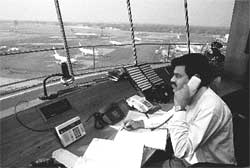Flying safely
 the mid-air collision over Charkhi Dadri near Delhi might not have taken place if the Saudia and Kazakhstan Airlines had been using a Traffic Alert Collision Avoidance System (tcas). tcas or Airborne Collision Avoidance System (acas) is the air-to-air communication system that issues audio-visual warnings to the pilots whenever two or more aircraft come very close. If the warnings are received in time, pilots can manoeuvre the aircraft to safety. According to International Airport Authority of India officials, the system may soon become mandatory for all airlines operating around the world.
the mid-air collision over Charkhi Dadri near Delhi might not have taken place if the Saudia and Kazakhstan Airlines had been using a Traffic Alert Collision Avoidance System (tcas). tcas or Airborne Collision Avoidance System (acas) is the air-to-air communication system that issues audio-visual warnings to the pilots whenever two or more aircraft come very close. If the warnings are received in time, pilots can manoeuvre the aircraft to safety. According to International Airport Authority of India officials, the system may soon become mandatory for all airlines operating around the world.
Government or international agencies such as International Civil Aviation Organisation (icao) allot specific air routes to the airlines. To prevent collisions on this route, Air Traffic Controllers (atcs) on ground provide information for necessary separation between aircraft flying on the same routes. However, there is always a possibility of a mid-air collision if any of the safety measures are not followed.
In such cases, tcas may track aircraft and display them on the screen. The system is completely independent of ground-based equipment. A transponder on-board an aircraft transmits radio-signals to the another aircraft fitted with the same device. It helps pilots communicate with each other during emergencies. The difference in time taken to transmit and receive a message allows calculation of the distance. The information in terms of distance and altitude is displayed visually on a screen in the cockpit.
tcas is so sophisticated that the audio-visual warnings known as Traffic Advisories (ta) offer the pilot enough time to manoeuvre the aircraft safely. The ta range is normally six nautical miles (nearly 10 km) or 1200
Related Content
- Joint committee report on land pollution in village Nangla Bujurg and pollution of Begrajpur drain, Muzaffarnagar, Uttar Pradesh, 13/02/2023
- Disposal of fly ash in an environment friendly manner: NGT passes order
- Final assessment report on the environmental carrying capacity study for expansion of 2 X 600 MW Udupi power plant, Karnataka, 24/01/2022
- Order of the National Green Tribunal regarding fly ash barge capsizing incidents in river Hooghly in West Bengal, 19/10/2020
- Judgement of the National Green Tribunal regarding the waste to energy plant close to Okhla STP, 02/02/2017
- The impact of drinking water quality and sanitation on child health: evidence from rural Ethiopia
